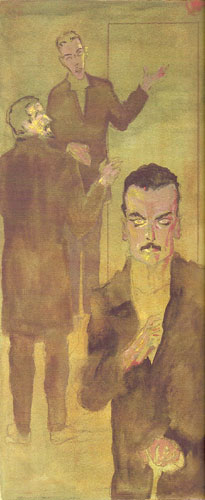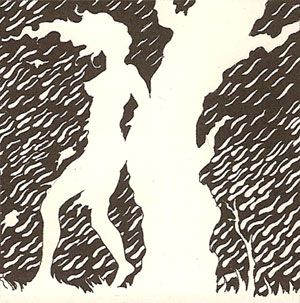
Lost Girls
Does Alan Moore require any introduction ? Miracle Man, Swamp Thing, V for Vendetta, Watchmen, From Hell, The League of Extraordinary Gentlemen — the man can boast an impressive bibliography, complete with a hefty dose of major and important works. Needless to say that the long-delayed conclusion to one of his cursed projects[1] was an event in itself.
And without a doubt, the release of Lost Girls was an event, be it in the choice of the publisher (the modest Top Shelf[2] ) or in the scandalous subject of the book — raising the outrage of Peter Pan‘s right-holders,[3] praising the financial gamble of an audacious first printing (40,000 copies of a $75 book), or even reporting Alan Moore’s declarations, adamant that the book wasn’t about eroticism but pornography.
A few months have past, and all this excitement is long gone, Top Shelf has put out its third printing of the imposing work, and Alan Moore is about to wed the book’s artist Melinda Gebbie. And for us readers, now is the time to consider quietly what this Lost Girls really has to deliver.
Let me provide a quick summary of the story : using the same concept as for the League,[4] Alan Moore sets up the meeting of three literary characters, three women who will share their sexual experiences on a background of impending world war. Therefore introducing Lewis Caroll’s Alice, Peter Pan‘s Wendy and Dorothy for the Wizard of Oz, whose trajectories intersect in a hotel in Austria.
From this compelling starting point, Alan Moore sets out to use all the narrative techniques he’s famous for, playing with page layout and narrative echoes, all this integrated in a complex system that is not without reminding of OuLiPian works such as Georges Pérec’s La vie mode d’emploi. Thus, each one of the thirty chapters of this book is composed of eight pages (or the number of squares in the side of a check board, a reccuring pattern of Through the Looking-Glass), each narrator with a distinctive voice corresponds to a specific page layout, as well as a clearly identified symbolic array.
Sprinkling the text with quotes and references to the three source works, playing with the connections between the story and History, Alan Moore seems compelled to introduce echoes, and to forcibly deliver an erudite tale within a tale — up until the book itself, white-bound under the covers, which brings back to Rougeur’s “white book”, a collection of licentious short stories and illustrations.
This tendency pervades the whole book, mentioning authors or artists who, in their own time, were scandalous, from Ego Schiele (arrested for his erotic drawings and suspected of seducing and abducting a minor) to Oscar Wilde (convicted of gross indecency and sentenced to two years’ hard labor), including lesser known Aubrey Beardsley and Franz von Bayros, in the order to establish some kind of filliation.
The claim of legacy also comes with a need for justification, directly expressed in the incest chapter, where Alan Moore speaks through the character of Rougeur to assert his right to the most extreme pornography. The same Rougeur will end up being revealed a talented counterfeiter — similar to Pierre Louÿs,[5] and without a doubt to Alan Moore himself, who delivers here a story rich in Sapphic embraces.
Indeed, in the construction of Lost Girls, Alan Moore is something of a counterfeiter, playing here on a theme that was very distant from his usual fare. But contrary to Rougeur, the Watchmen author struggles along, and delivers a book that is more fastidious than pornographic. From pornography, he borrows the accumulation principle — accumulation of couplings in general, but in particular the accumulation of all possible combination, to the point that the whole ends up looking like a rather boring inventory.
Eventually, all this debauchery does not manage to overcome the oppressing weight of the narrative system, a system ever-present for the reader. The search for a formal richness then unravels without subtlety — devices becoming far too obvious, each chapter turning into another opportunity for a new performance. The whole thing is so much intellectualized, that the pornographic aspect disappears, crushed under the overabundance of symbols and erudite references.
Melinda Gebbie’s art could also be blamed — most of the time somewhat tedious, and meeting its main demise in the choice of color for most of the book. Indeed, the rare black and white pages are in the end the only ones where a refined and precise sensuality blossoms, far from the rather unnecessary gaudiness of the color illustrations.
In this way, if Watchmen and The League presented, each in its own way, a donquixotesque deconstruction of the popular hero figure, the purpose of Lost Girls comes through with less clarity, suffering from the lack of a real message under a heavily-handed narrative mastery.
In my (French) dictionary, pornography is defined as “the complacent representation of obscene topics or details, within an artistic, literary or cinematographic work”. In the end, beyond the numerous and varied demonstrations of debauchery, it might be in the complacency of the author resorting too much to his efficient narrative system that Lost Girls borders on pornography.
Notes
- For the record, the first six chapters of Lost Girls appeared in 1991 in the anthology Taboo and then published in two collections by Kitchen Sink Press. But the story had to wait until August 2006 (or fifteen years after the publication of the first pages) to come to its conclusion with the release of the three-book in their slipcase by Top Shelf. This only leaves the ambitious Big Numbers, but without much hope.
- Preferred to DC for the next book of The League of Extraordinary Gentlemen, or the conclusion to a rather tumultuous collaboration.
- The Great Ormond Street Hospital, recipient of J.M. Barrie’s copyright, and which protests led Top Shelf to delay the publishing of Lost Girls in the United Kingdom until those rights expire at end 2007.
- Which was created after Lost Girls.
- Author of the Chansons de Bilitis, which he presented as the works of a Greek poetess, contemporary of Sappho.
 l’autre bande dessinée
l’autre bande dessinée





